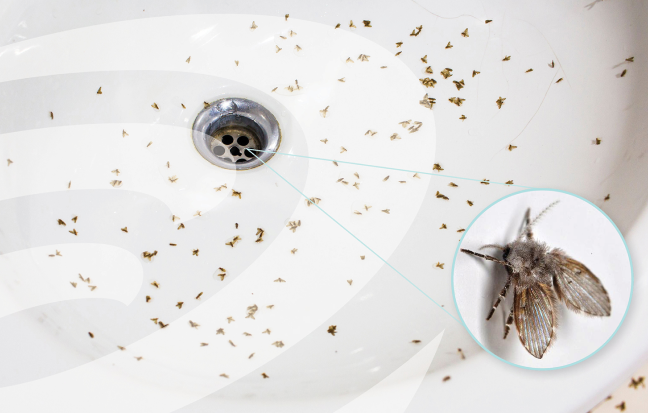
Just imagine for a while that after a long, hectic day, you went to your bathroom to get yourself relaxed, and what you came across was a swarm of tiny flies buzzing around the sink. How do you feel about them? They might seem harmless, but annoy you to your core because they will keep coming back. These unwelcome guests are basically drain flies, or you can also call them sink flies or sewer flies.
Drain flies thrive in hidden corners of sinks, pipes, and drains, making them difficult to control if you do not fully understand what attracts them and how they breed. What makes them frustrating is their persistence. You clean, you spray, you pour hot water, but within days, they return as if nothing happened. This blog will give you a complete walkthrough on how to identify them, understand why they appear, the health risks linked to them, and the most effective ways to get rid of them for good.
What Are Drain Flies?
Drain flies are tiny insects that grow to about 1.5 to 5 millimeters in size. Because of their wings, they seem like a moth. Unlike fruit flies that hover around the fruits or any sweet item, drain flies are usually found in organic matter and standing water inside drains.
They breed inside sinks, bathroom drains, and even in shower drains. These are basically their living space, or you can say that’s where they are found. The adult flies are usually spotted resting on walls or near the sink, while their larvae live inside the slimy buildup inside your drainpipes.
Why Do They Appear in Kitchens, Bathrooms, and Drains?
The main reason drain flies appear is the presence of stagnant water and organic buildup inside pipes. Sinks, tubs, and toilets that are rarely used are particularly attractive to them because water collects and remains undisturbed.
Here are the most common reasons they choose your bathroom or kitchen:
- Organic matter builds up inside pipes.
- Standing water under sinks or behind toilets.
- Leaking pipes that create moist breeding grounds.
- Rarely used drains that collect slime and bacteria.
Health Risk Factors Linked to Drain Flies
Although drain flies do not bite or transmit deadly diseases, they are not completely harmless. Because they live and breed in dirty drains, they can carry bacteria from those areas and deposit them on bathroom surfaces, sinks, and even food in kitchens.
Health risks include:
- Possible skin irritation or allergic reactions in sensitive individuals.
- Spread of bacteria from contaminated surfaces.
- Worsening of asthma or respiratory issues if infestations are left untreated.
For households with children, elderly family members, or pets, the presence of these flies can be particularly concerning.
Cost Breakdown Summary
The cost of installing a sump pump is rarely a flat figure. Several components contribute to the final bill.
As shown above, labor often takes the largest share, followed by the pump unit itself. Materials like piping, gravel, or backup batteries add to the bill, along with permits and inspections in regulated areas.
Methods to Get Rid of Drain Flies
When it comes to removing drain flies, the goal is not just killing the adults you see but also eliminating their breeding grounds inside drains. Here are the most effective methods:
Boiling Water
Pouring boiling water directly down the drain is one of the simplest and most immediate remedies. It loosens grease and kills larvae hiding in slimy layers. Repeating this process two to three times a day for a week can significantly reduce infestations.
Apple Cider Vinegar Trap
Place a bowl filled with apple cider vinegar near the sink or bathroom drain. Cover it with plastic wrap and poke small holes in it. Adult flies are drawn to the vinegar, enter the trap, and get stuck. This helps reduce the adult population while you target the larvae in drains.
Baking Soda and Vinegar
A mix of baking soda and vinegar not only kills larvae but also cleans drains thoroughly. Pour half a cup of baking soda followed by half a cup of vinegar into the drain. Allow it to fizz for 15 minutes, then flush with boiling water.
Commercial Drain Cleaners
There are specialized cleaners available in the market designed to target organic matter and biofilm buildup in drains. These cleaners reach deep into pipes and destroy larvae where home remedies may not.
DIY Drain Cleaner
If you prefer a homemade approach, mix salt, baking soda, and vinegar. Pour this mixture into the drain and leave it overnight. The next morning, flush it with boiling water. This method attacks larvae and breaks down slime effectively.
Repair Leaks
Moisture is the lifeline of drain flies. Check for leaking pipes under sinks or behind toilets. Fixing these leaks not only prevents infestations but also protects your home from larger plumbing issues.
Remove Standing Water
Check trays under refrigerators, mop buckets, or corners in bathrooms where water may be collecting. Removing all stagnant water eliminates breeding spots outside of drains.
Drain Fly Larvae
Larvae are basically the baby flies that live inside the pipes, because they need slime and organic matter to thrive in their lives. These flies took 9 to 15 days to grow into adult flies. This is also one of the reasons that these can return quickly if a few of them are killed, because in the meantime, the larvae grow into adult ones. That’s why killing the adult ones isn’t the solution if you are not addressing the larvae’s
Comparison Between Drain Flies and Fruit Flies
People often confuse drain flies with fruit flies. Understanding the difference is key because the treatment methods vary.
Feature | Drain Flies | Fruit Flies |
Appearance | Fuzzy wings, moth-like | Small, smooth, red eyes |
Breeding Ground | Drains, standing water, slime | Rotten fruit, sugary items |
Common Locations | Bathrooms, sinks, floor drains | Kitchens, fruit baskets |
Primary Solution | Drain cleaning | Removing fruits and sweets |
Keep Your Home Drain Fly Free with Best Choice Plumber
When DIY methods won’t work, you might need professional assistance for such heavy infestations. Best Choice plumbers here help you to avoid such a mess. They identify the hidden leaks, perform deep underground drain cleaning, and make sure to keep your home healthy and fly-free.
We also provide emergency drain cleaning services if the infestations get out of control.
Final Words
Drain flies must be tiny and harmless, but their presence can make them a huge nuisance in any home. When you understand how they breed, where they come from, you can easily break the cycle of infestations by getting rid of them. Also, always remember that killing them is not the only solution; you must know how to deal with the root cause of it. The best way to keep these stubborn and irritating flies away from your home is to clean the drains, repair leaks, and remove stagnant water if any.
Frequently Asked Questions
Adult drain flies usually live for 1 to 3 weeks, but because they breed quickly, infestations seem endless if not treated properly.
No, they do not bite humans or pets, but they can spread bacteria from dirty drains.
You may see slimy worm-like larvae inside drains or notice that the flies return quickly after adults are killed.
If larvae inside drains are not killed or if leaks and standing water remain, the infestation will return.
